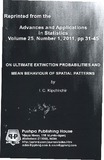| dc.contributor.author | Kipchirchir, I C | |
| dc.date.accessioned | 2013-06-14T08:39:38Z | |
| dc.date.available | 2013-06-14T08:39:38Z | |
| dc.date.issued | 2000 | |
| dc.identifier.citation | On Ultimate Extinction Probabilities And Mean Behaviour Of Spatial Patterns Reprint from (Advances and Applications in Statistics) Volume 25, Number 1,2011, Pages 31-45 | en |
| dc.identifier.uri | http://hdl.handle.net/11295/33693 | |
| dc.description.abstract | The three basic spatial patterns of organisms are clustering (overdispersion), randorrmess and uniformity (underdispersion). In this paper, deterministic and stochastic models are employed to describe the dynamics of the number of individuals in a habitable site called a unit. Stochastic model discriminates spatial patterns whereas deterministic model does not, however.xhe mean of stochastic model is equivalent to the deterministic model. The probabilities of ultimate extinction and ultimate mean number of individuals in a unit are determined using the stochastic model. The analysis demonstrated that if spatial pattern is uniform (underdispersed), ultimate extinction is certain; if spatial pattern is clustered (overdispersed), ultimate explosion is certain and if spatial pattern is random, ultimately it stabilizes. | en |
| dc.language.iso | en | en |
| dc.publisher | University of Nairobi | en |
| dc.title | On Ultimate Extinction Probabilities And Mean Behaviour Of Spatial Patterns | en |
| dc.type | Article | en |
| local.publisher | School of Mathematics University of Nairobi | en |

